Unmarked antique cast iron skillets are like hidden treasures waiting to be discovered, each one whispering tales of bygone eras and culinary traditions.
In the world of cast iron aficionados, these unmarked gems hold a special allure, challenging collectors and enthusiasts to unravel their mysteries and uncover their origins.
This identification guide is your passport to the captivating realm of unmarked antique cast iron skillets, where every marking, handle style, and manufacturing detail tells a story of craftsmanship and heritage.
Embark on a journey of exploration as we delve into the nuances of these timeless culinary companions, offering insights and tips to help you navigate the rich landscape of antique cast iron cookware with confidence and excitement.

Unmarked Antique Cast Iron Skillet Identification Guide
Identifying an unmarked antique cast iron skillet can be a fascinating journey into culinary history and craftsmanship. While many cast iron skillets bear clear markings indicating their brand or maker, unmarked ones require a bit more detective work. Here’s a guide to help you identify an unmarked antique cast iron skillet:
Tip #1: Start With The Brand

When identifying an unmarked antique cast iron skillet, a valuable tip is to start by considering the brand. While the absence of a visible brand stamp can make identification challenging, certain characteristics often associated with specific brands can provide clues.
For example, Griswold and Wagner are renowned for their smooth cooking surfaces and distinctive handle designs. Lodge, another well-known brand, often produced skillets with a rougher surface texture and thicker walls.
By researching the characteristics and history of different brands, you can narrow down the possibilities and make more informed conclusions about the origin of an unmarked cast iron skillet.
Tip #2: Go To Google
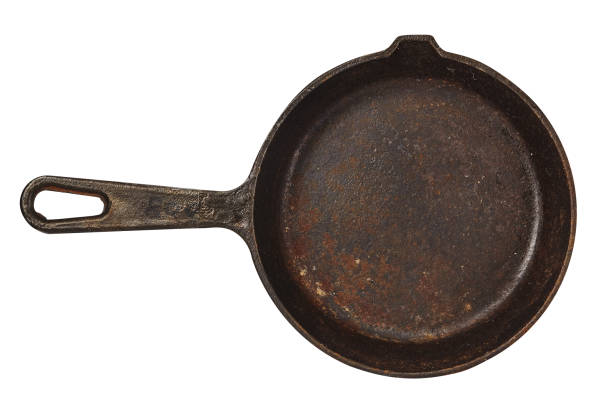
Another helpful tip when identifying an unmarked antique cast iron skillet is to turn to Google.
The internet is a treasure trove of information, and a quick search using keywords related to cast iron cookware, such as “antique cast iron skillet identification,” can yield valuable results.
Online forums, collector websites, and historical archives often have detailed discussions, photographs, and guides that can assist in identifying the age, maker, and rarity of unmarked cast iron skillets.
Moreover, utilizing image search tools can help compare the features of your skillet with known examples, providing visual references that aid in the identification process.
Tip #3: Review Old Logos

When attempting to identify an unmarked antique cast iron skillet, a useful strategy is to review old logos associated with cast iron cookware manufacturers.
Many companies used distinct logos and markings on their products, even if they didn’t always stamp their brand names directly onto the skillets.
By researching and familiarizing yourself with the logos and trademarks of historical cast iron makers like Griswold, Wagner, Lodge, and others, you can often match these symbols to unmarked skillets, providing valuable clues about their origins and approximate age.
Online resources, vintage catalogs, and collector guides are excellent sources for finding and studying these old logos.
Tip #4: Check For Provenance
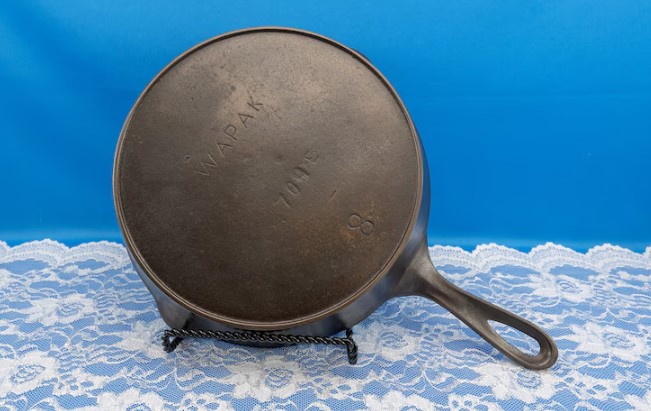
Another valuable tip for identifying an unmarked antique cast iron skillet is to check for provenance. Provenance refers to the documented history or ownership trail of an item, which can provide crucial information about its age, maker, and authenticity.
If you acquired the skillet from a reputable source such as an antique store, auction house, or collector, inquire about any accompanying documentation or details regarding its origin.
Look for any signs of previous ownership, such as labels, tags, or inscriptions that might offer insights into the skillet’s history.
Moreover, consider researching the history of the area where the skillet was found or purchased, as certain regions were known for specific cast iron manufacturers or styles during different time periods.
By gathering provenance information, you can enhance your understanding of the skillet’s background and increase the likelihood of accurately identifying it.
Tip #5: Look At The Bottom
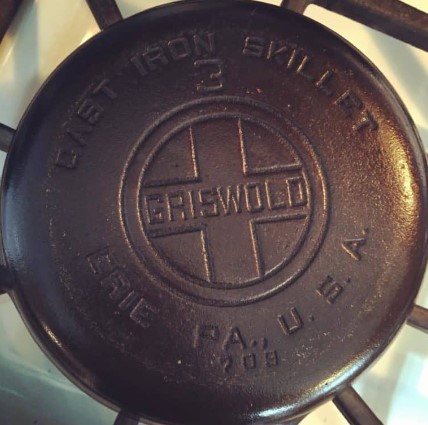
When identifying an unmarked antique cast iron skillet, don’t overlook the importance of examining the bottom. The bottom of a skillet can reveal valuable clues about its age, manufacturing techniques, and potential origin.
Look for features such as a heat ring, which was common in older skillets and can indicate a vintage piece. Check for any markings, numbers, or symbols that might be faint or partially obscured, as these could be remnants of a brand stamp or manufacturer’s mark.
Pay attention to the texture and finish of the bottom surface, as older skillets often have smoother bottoms due to hand-finishing processes.
Moreover, note any casting flaws, seams, or irregularities that can provide insights into the skillet’s production methods and era.
By thoroughly examining the bottom of an unmarked cast iron skillet, you can gather valuable clues that aid in its identification.
Tip #6: Inspect The Spout
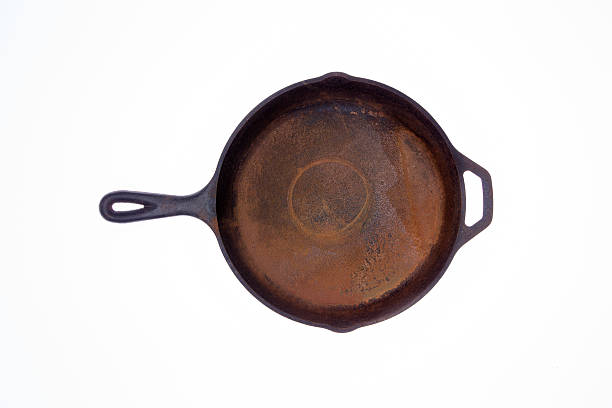
When identifying an unmarked antique cast iron skillet, an often overlooked but important detail to inspect is the spout. Some older cast iron skillets, especially those designed for specific purposes like pouring liquids or sauces, may have a spout that sets them apart from regular skillets.
Start by examining the shape and size of the spout. Antique skillets with spouts typically have a distinctive design that differs from modern skillets. Look for any signs of wear or usage around the spout area, which can indicate the skillet’s age and previous use.
Moreover, check if the spout is integrated seamlessly into the skillet or if it’s a separate piece attached during manufacturing. Some antique skillets may have detachable spouts or spouts that are part of a set, which can provide clues about their intended use and origin.
By paying attention to the spout and its characteristics, you can gather valuable information that helps in identifying and understanding the unique features of an unmarked antique cast iron skillet.
Tip #7: Look Closer At The Handle
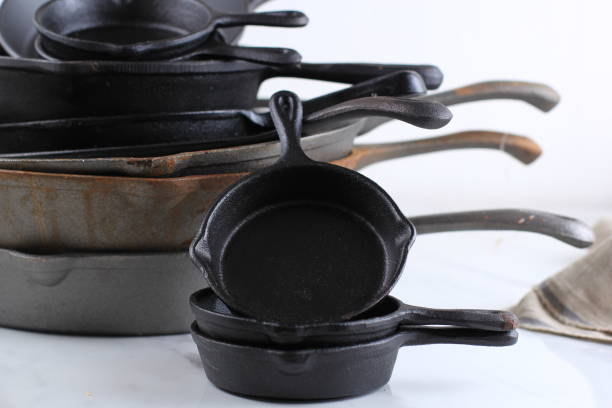
When trying to identify an unmarked antique cast iron skillet, it’s crucial to closely examine the handle. The handle can offer valuable clues about the skillet’s age, manufacturer, and intended use. Here are some tips for inspecting the handle:
- Handle Shape: Different brands and time periods often had distinct handle shapes. For example, older skillets may have handles that are thinner and more curved, while later models could have thicker, straighter handles.
- Handle Attachment: Check how the handle is attached to the skillet. Early skillets typically had handles that were attached with raised tabs or circular shapes known as “ears,” while later skillets might have handles attached with flat tabs or bolts.
- Handle Design: Look for any decorative elements or unique designs on the handle. Some manufacturers, like Griswold and Wagner, stamped their logos or trademarks on the handles, even if the skillet itself was unmarked.
- Handle Material: Note the material of the handle. Antique cast iron skillets often had handles made of cast iron as well, although some later models may have handles made of different materials like wood or Bakelite.
- Handle Condition: Examine the handle for any signs of wear, rust, or repairs. A well-worn handle with a smooth patina can indicate an older skillet that has seen years of use.
By thoroughly inspecting the handle of an unmarked cast iron skillet, you can gather valuable information that helps in determining its age, origin, and authenticity.
Tip #8: Get Information From Books

Another effective tip for identifying an unmarked antique cast iron skillet is to gather information from books dedicated to cast iron cookware.
There are several comprehensive guides and reference books written by experts in the field that provide detailed insights into the history, manufacturing techniques, and identifying features of antique cast iron skillets.
Look for books that cover topics such as the evolution of cast iron cookware, notable manufacturers and their trademarks, characteristic design elements of different time periods, and tips for identifying unmarked skillets based on specific features.
These books often include photographs, illustrations, and detailed descriptions that can be invaluable in your identification process.
Some books may focus on specific brands or eras, offering in-depth knowledge that can help you narrow down the possibilities and make more accurate assessments about the age and origin of an unmarked cast iron skillet.
Be sure to consult reputable sources and reference materials to enhance your understanding and improve your chances of successfully identifying antique cast iron cookware.
Tip #9: Look Into The Numbers
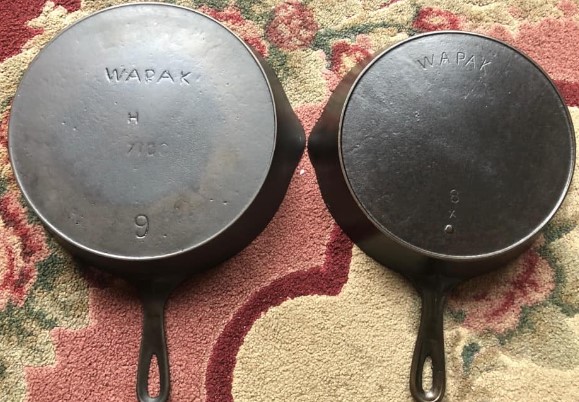
When identifying an unmarked antique cast iron skillet, another tip is to closely examine any numbers that may be present on the skillet. While the absence of a visible brand name or logo can make identification challenging, numbers such as model numbers, size numbers, or pattern numbers can provide valuable clues.
- Model Numbers: Some manufacturers stamped model numbers on their cast iron cookware, which can indicate the specific design or style of the skillet. Compare any numbers you find with known model numbers from reputable sources to help narrow down the possibilities.
- Size Numbers: Antique cast iron skillets often have size numbers stamped on the bottom or handle, indicating the diameter or capacity of the skillet. Refer to size charts or guides to determine the approximate age and manufacturer based on the size number.
- Pattern Numbers: In addition to model and size numbers, some skillets may have pattern numbers that refer to the design or mold used in production. Researching pattern numbers can provide insights into the origin and production era of the skillet.
- Additional Numbers: Look for any other numbers, letters, or symbols that may be present on the skillet. These markings could be production codes, batch numbers, or manufacturer identifiers that help in the identification process.
By carefully examining and researching the numbers on an unmarked cast iron skillet, you can gather valuable information that enhances your ability to identify its age, maker, and potential rarity.
Tip #10: Hunt For Ghosts
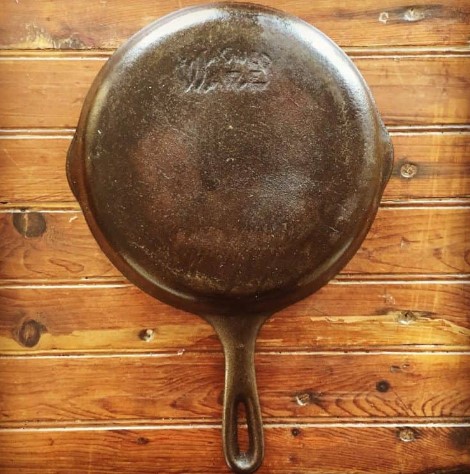
When identifying an unmarked antique cast iron skillet, a fascinating strategy is to hunt for “ghosts.” In the world of cast iron cookware, ghosts refer to faint or partially obscured markings that may reveal hidden information about the skillet’s origin or maker. Here are some tips for hunting ghosts:
- Lighting: Use a bright light source, such as a flashlight or desk lamp, to illuminate the bottom and sides of the skillet. Shadows and reflections can sometimes make faint markings more visible.
- Magnification: Use a magnifying glass or a smartphone with a macro lens attachment to zoom in on specific areas of the skillet. This can help you spot tiny details that are not easily visible to the naked eye.
- Cleaning: Gently clean the surface of the skillet with a soft cloth or brush to remove any dirt, grime, or old seasoning. Sometimes, ghost markings can be obscured by buildup or residue.
- Heat Test: If the skillet is safe to use, heat it on a stovetop or in the oven. Heat can sometimes bring out faint markings or colors that are not visible at room temperature.
- Chemical Methods: Use safe and non-abrasive chemical methods, such as vinegar or baking soda paste, to gently remove stubborn residues without damaging the skillet. Be cautious and avoid harsh chemicals that can harm the cast iron.
- Patience: Hunting for ghosts requires patience and attention to detail. Take your time to thoroughly inspect the skillet from different angles and under varying lighting conditions.
By hunting for ghosts on an unmarked cast iron skillet, you may uncover hidden markings, logos, or numbers that provide valuable clues about its history, maker, and age. This intriguing approach adds a sense of mystery and discovery to the identification process.
Find The Magic Mark!
In the realm of antique cast iron cookware, finding the “magic mark” can unlock valuable insights into the skillet’s origin and history. The magic mark refers to any faint, hidden, or partially obscured markings that may reveal important information about the skillet’s maker, production era, or specific characteristics. Here are some tips for finding the magic mark:
- Clean and Prepare: Start by gently cleaning the skillet using mild soap and warm water. Remove any dirt, grime, or old seasoning that could obscure markings. Avoid harsh scrubbing or abrasive cleaners that may damage the cast iron.
- Inspect Carefully: Thoroughly inspect the entire surface of the skillet, including the bottom, sides, handle, and interior cooking surface. Use a bright light source and magnifying tools to aid in your inspection.
- Look for Faint Impressions: Sometimes, magic marks can be faint impressions rather than clear stamps or engravings. Pay attention to areas where there may be slight indentations or discolorations that could indicate hidden markings.
- Heat and Contrast: Heat the skillet gently to a low temperature, which can sometimes bring out hidden markings or colors that are not visible at room temperature. Contrast the skillet against different backgrounds or surfaces to make faint marks more noticeable.
- Chemical Methods: Consider using safe and non-abrasive chemical methods, such as vinegar or baking soda paste, to gently remove surface residues and reveal hidden markings. Test these methods on a small, inconspicuous area first to ensure they won’t damage the cast iron.
- Research and Compare: Once you’ve found a potential magic mark, research similar markings from known cast iron manufacturers and compare them with your findings. Look for similarities in logos, symbols, or numbers to narrow down the possibilities.
By diligently searching for the magic mark and employing careful inspection techniques, you can uncover hidden details that enhance your understanding of an unmarked antique cast iron skillet and its fascinating story.
Frequently Asked Questions (FAQs) – Unmarked Antique Cast Iron Skillet Identification Guide
Q: What makes identifying unmarked antique cast iron skillets exciting?
A: Unmarked antique cast iron skillets are like hidden treasures waiting to be discovered! Their unmarked nature adds an element of mystery and adventure to the identification process, making it a thrilling journey for collectors and enthusiasts alike.
Q: Why are unmarked antique cast iron skillets valuable to collectors?
A: Unmarked antique cast iron skillets hold immense value for collectors due to their historical significance, craftsmanship, and rarity. Each skillet tells a unique story, making them highly sought-after and prized additions to any collection.
Q: What are the key features to look for when identifying unmarked antique cast iron skillets?
A: Identifying unmarked antique cast iron skillets involves examining their size, weight, handle design, heat ring presence, and cooking surface characteristics like smoothness and seasoning patterns. These features provide clues about the skillet’s age, maker, and quality.
Q: How can beginners start identifying unmarked antique cast iron skillets?
A: Beginners can start by researching reputable resources, joining collector communities, and learning from experienced collectors. Hands-on experience, careful observation, and comparing skillets with known examples can also help develop identification skills.
Q: What are the benefits of owning a guide for identifying unmarked antique cast iron skillets?
A: Owning a guide for identifying unmarked antique cast iron skillets streamlines the identification process, increases confidence in authenticity, and enhances the overall collecting experience. It’s a valuable tool that empowers collectors to make informed decisions and appreciate their finds even more.
Q: Are there any tips for preserving and maintaining unmarked antique cast iron skillets?
A: Yes, preserving and maintaining unmarked antique cast iron skillets involves seasoning regularly, storing in a dry place, avoiding harsh cleaning methods, and handling with care to prevent damage. Following these tips ensures the skillets retain their beauty and functionality for generations to come.
Q: What are some fascinating stories or anecdotes associated with unmarked antique cast iron skillets?
A: Unmarked antique cast iron skillets often come with intriguing stories about their origins, previous owners, and historical significance. These stories add depth and character to each skillet, making them more than just collectibles but pieces of living history.
Q: How can identifying unmarked antique cast iron skillets contribute to preserving culinary heritage?
A: Identifying unmarked antique cast iron skillets contributes to preserving culinary heritage by recognizing and appreciating the craftsmanship, techniques, and traditions of past generations. It connects us to our culinary roots and inspires a deeper appreciation for cooking history.
Q: What are some common misconceptions about unmarked antique cast iron skillets, and how can they be clarified?
A: Common misconceptions about unmarked antique cast iron skillets include assumptions about age, maker, and value based solely on markings. Clarifying these misconceptions involves educating collectors about other identifying factors and the rich diversity within the world of unmarked cast iron cookware.
Conclusion
In conclusion, navigating the world of unmarked antique cast iron skillets can be a fascinating journey for collectors and enthusiasts alike.
Through this identification guide, we’ve delved into the intricate details of these timeless kitchen treasures, from understanding their unique features and designs to deciphering their historical significance.
By honing your skills in identifying unmarked cast iron skillets, you not only unlock the stories behind these culinary artifacts but also contribute to preserving a rich culinary heritage for generations to come.
So, whether you’re a seasoned collector or just beginning your cast iron journey, may this guide serve as a valuable resource in your quest for discovering and appreciating the beauty and craftsmanship of unmarked antique cast iron skillets.
Other Articles You May Also Like: